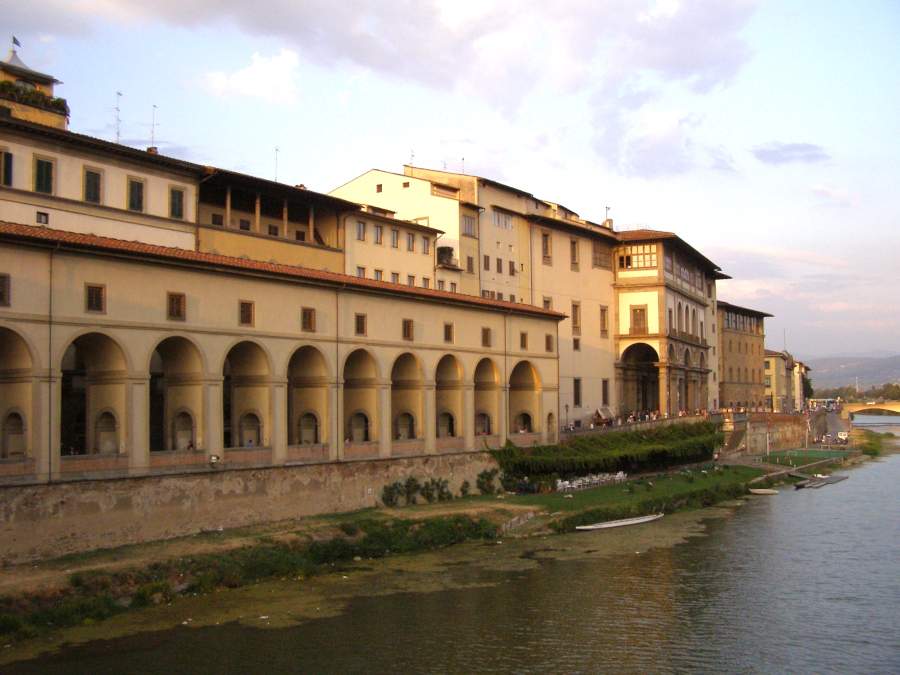Restoration of one of Florence’s most beautiful terraces, the Terrazza Vasariana on the Arno, is underway. An overlook over the Arno on the Lungarno Anna Maria Luisa dei Medici, with the Uffizi square behind it, from which there is an unparalleled view of the Ponte Vecchio.
Exposure to the elements has caused its gradual deterioration, and for the Terrazza Vasariana the time has come for complete restoration. Like any other outdoor asset, the Terrace is exposed to rain, cold and sun. Restoration operations include both the recovery of the stone elements that make up the balustrade, the cornices, the brackets that support the vaults, the plasterwork, and finally the structural consolidation of the upper part as well.
Infesting vegetation will be removed and cleaning operations will be carried out by hand and with chemical compresses. Grouting and sealing will be carried out where necessary, as well as consolidation of the masonry. To operate the structural consolidation, it is necessary to remove the stone sidewalk of the terrace and the small sidewalk up to the roadway and to consolidate the subgrade and screed. When the work is done, the original slab will be put back in place. The windows under the vaults will be fitted with new anti-volatile nets.
Construction will start in the spring when the water in the Arno will be lower, allowing work to be done without risk of flooding.
The work will cost 300,000 euros, begin in the spring and last six months. The resolution was signed by Mayor and Councilor for Culture Dario Nardella.
“We never stop taking care of our artistic and architectural heritage,” Mayor Nardella stressed. “The maintenance, preservation and enhancement of our cultural heritage did not fail even during the hardest period of the pandemic, and we see this as an opportunity not to be wasted for the restart. From this Terrace we offer one of the most striking views of Ponte Vecchio and we also want the balustrades, handrails, stone elements but also the whole part below, invisible to most, to be restored to their original beauty.”
Already in the decade of 1540-50 Duke Cosimo I de’ Medici had conceived the idea of bringing together the city’s major corporations and administrative and executive functions in the area of the Piazza Ducale. In 1546 he had had the road from the Ducal Palace to the Arno opened, with the intention of constructing a building to house thirteen of the major Magistracies of the Medici State. But it was not until Giorgio Vasari ’s arrival in Florence that the idea became a reality: in just four months, in 1560, the model was ready, and under his direction work on the Uffizi began. In 1574 upon the deaths of Cosimo and Vasari, which occurred within months of each other, the former the building is largely but not finally completed. The Uffizi square squeezed between the buildings is configured at the same time as a courtyard-square, but also as a path. Interesting in the qualification as an ’interior’ of the Uffizi space is the use of ’serene’ stone, usually used in interior courtyards, instead of ’strong’ stone. As early as the end of the 15th century, due to the influence of Brunelleschi’s architecture, the use of pietra serena was widespread, which compared to pietra forte requires greater protection from the elements. In the Uffizi factory, Vasari solves this problem by creating an eave with overhangs of more than two meters, which is an essential element of the architecture of the Uffizi. Moreover, the fabbrica is an interesting experience in building technique; in fact, the use of metal reinforcement of the stone and other devices in the wall apparatus make it possible to achieve structural continuity. Vasari was aware of the importance of these technical solutions and reserved the introductory chapter of the Lives for their description.
 |
| Florence, the Terrazza Vasariana on the Arno will be fully restored in spring |
Warning: the translation into English of the original Italian article was created using automatic tools. We undertake to review all articles, but we do not guarantee the total absence of inaccuracies in the translation due to the program. You can find the original by clicking on the ITA button. If you find any mistake,please contact us.